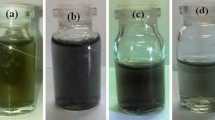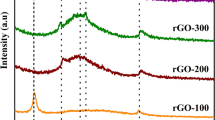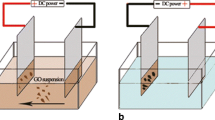Abstract
The reduced graphene oxide (rGO) has attracted more and more attention in recent years. How to choose a suitable reduction method to prepare rGO is a critical problem in the preparation of graphene composites. In this work, the differences of rGO reduced by thermal, microwave, Ultraviolet (UV) and reducing agent were studied. The reduction degree and functional groups of rGO were compared by SEM, XPS, Raman, FTIR and TGA. Thermal can remove most of the oxygen-containing groups of graphene oxide (GO) and the thermal reduction is the most effective reduction method. UV light can directly act on the unstable oxygen-containing groups, and its reduction efficiency is second only to thermal reduction. The efficiency of chemical reduction is not as good as that of UV reduction, because the reducing agent only act on the surface of GO. Microwave reduction is a mild thermal reduction with the lowest efficiency, but the residual oxygen-containing groups increase the hydrophilicity of rGO. To sum up, this work studies that rGO prepared by different reduction methods has different characteristics, which provides a reference for selecting appropriate reduction methods to prepare graphene composites with better properties.
Graphic abstract






Similar content being viewed by others
References
Pumera M (2011) Graphene-based nanomaterials for energy storage. Energy Environ Sci 4(3):668–674
Zhang YT, Zhang KB, Jia KL, Liu GY, Ren SZ, Li KK et al (2019) Preparation of coal-based graphene quantum dots/alpha-Fe2O3 nanocomposites and their lithium-ion storage properties. Fuel 241:646–652
Deng F, Olvera-Vargas H, Garcia-Rodriguez O, Zhu Y, Jiang J, Qiu S et al (2019) Waste-wood-derived biochar cathode and its application in electro-Fenton for sulfathiazole treatment at alkaline pH with pyrophosphate electrolyte. J Hazard Mater 377:249–258
Iftikhar T, Xu Y, Aziz A, Ashraf G, Li G, Asif M et al (2021) Tuning electrocatalytic aptitude by incorporating α-MnO2 nanorods in Cu-MOF/rGO/CuO hybrids: electrochemical sensing of resorcinol for practical applications. ACS Appl Mater Interfaces 13(27):31462–31473
Asif M, Aziz A, Wang H, Wang Z, Wang W, Ajmal M et al (2019) Superlattice stacking by hybridizing layered double hydroxide nanosheets with layers of reduced graphene oxide for electrochemical simultaneous determination of dopamine, uric acid and ascorbic acid. Mikrochim Acta 186(2):61
Aziz A, Asif M, Azeem M, Ashraf G, Wang Z, Xiao F et al (2019) Self-stacking of exfoliated charged nanosheets of LDHs and graphene as biosensor with real-time tracking of dopamine from live cells. Anal Chim Acta 1047:197–207
Choi JH, Lee J, Byeon M, Hong TE, Park H, Lee CY (2020) Graphene-based gas sensors with high sensitivity and minimal sensor-to-sensor variation. ACS Appl Nano Mater 3(3):2257–2265
Zhu Y, Murali S, Stoller MD, Ganesh KJ, Cai W, Ferreira PJ et al (2011) Carbon-based supercapacitors produced by activation of graphene. Science 332(6037):1537–1541
Manjakkal L, Navaraj WT, Nunez CG, Dahiya R (2019) Graphene-graphite polyurethane composite based high-energy density flexible supercapacitors. Adv Sci 6(7):1802251
Deng F, Li S, Zhou M, Zhu Y, Qiu S, Li K et al (2019) A biochar modified nickel-foam cathode with iron-foam catalyst in electro-Fenton for sulfamerazine degradation. Appl Catal B 256:117796
Lee Y, Kim YT, Kwon EE, Lee J (2020) Biochar as a catalytic material for the production of 1,4-butanediol and tetrahydrofuran from furan. Environ Res 184:109325
Stankovich S, Dikin DA, Dommett GH, Kohlhaas KM, Zimney EJ, Stach EA et al (2006) Graphene-based composite materials. Nature 442(7100):282–286
Jiang JZ, Zhu LH, Zou J, Lei OY, Zheng AM, Tang HQ (2015) Micro/nano-structured graphitic carbon nitride-Ag nanoparticle hybrids as surface-enhanced Raman scattering substrates with much improved long-term stability. Carbon 87:193–205
Jeong G, Jung S, Choi Y, Lee J, Seo J, Kim DS et al (2018) A highly robust and stable graphene-encapsulated Cu-grid hybrid transparent electrode demonstrating superior performance in organic solar cells. J Mater Chem A 6(48):24805–24813
Paredes JI, Villar-Rodil S, Solis-Fernandez P, Martinez-Alonso A, Tascon JM (2009) Atomic force and scanning tunneling microscopy imaging of graphene nanosheets derived from graphite oxide. Langmuir 25(10):5957–5968
Shao GL, Lu YG, Wu FF, Yang CL, Zeng FL, Wu QL (2012) Graphene oxide: the mechanisms of oxidation and exfoliation. J Mater Sci 47(10):4400–4409
Compton OC, Nguyen ST (2010) Graphene oxide, highly reduced graphene oxide, and graphene: versatile building blocks for carbon-based materials. Small 6(6):711–723
Lesiak B, Trykowski G, Tóth J, Biniak S, Kvér L, Rangam N et al (2021) Chemical and structural properties of reduced graphene oxide—dependence on the reducing agent. J Mater Sci 56(5):3738–3754
Wu ZS, Ren W, Gao L, Zhao J, Chen Z, Liu B et al (2009) Synthesis of graphene sheets with high electrical conductivity and good thermal stability by hydrogen arc discharge exfoliation. ACS Nano 3(2):411–417
Pei SF, Cheng HM (2012) The reduction of graphene oxide. Carbon 50(9):3210–3228
Berger C (2006) Electronic confinement and coherence in patterned epitaxial graphene. Science 312(5777):1191–1196
Chen W, Yan L, Bangal PR (2010) Preparation of graphene by the rapid and mild thermal reduction of graphene oxide induced by microwaves. Carbon 48(4):1146–1152
Zhu Y, Murali S, Stoller M, Velamakanni A, Piner RD, Ruoff RS (2010) Microwave assisted exfoliation and reduction of graphite oxide for ultracapacitors. Carbon 48(7):2118–2122
Voiry D, Yang J, Kupferberg J, Fullon R, Lee C, Jeong HY et al (2016) High-quality graphene via microwave reduction of solution-exfoliated graphene oxide. Science 353(6306):1413–1416
Cote LJ, Cruz-Silva R, Huang J (2009) Flash reduction and patterning of graphite oxide and its polymer composite. J Am Chem Soc 131(31):11027–11032
Zhang Y, Guo L, Wei S, He Y, Xia H, Chen Q et al (2010) Direct imprinting of microcircuits on graphene oxides film by femtosecond laser reduction. Nano Today 5(1):15–20
Stankovich S, Piner RD, Chen X, Wu N, Nguyen ST, Ruoff RS (2006) Stable aqueous dispersions of graphitic nanoplatelets via the reduction of exfoliated graphite oxide in the presence of poly(sodium 4-styrenesulfonate). J Mater Chem 16(2):155–158
Zhou X, Zhang J, Wu H, Yang H, Zhang J, Guo S (2011) Reducing graphene oxide via hydroxylamine: a simple and efficient route to graphene. J Phys Chem C 115(24):11957–11961
Becerril HA, Mao J, Liu Z, Stoltenberg RM, Bao Z, Chen Y (2008) Evaluation of solution-processed reduced graphene oxide films as transparent conductors. ACS Nano 2(3):463–470
Lerf A, He H, Forster M, Klinowski J (1998) Structure of graphite oxide revisited. J Phys Chem B 102(23):4477–4482
Park S, Ruoff RS (2009) Chemical methods for the production of graphenes. Nat Nanotechnol 4(4):217
Cao J, Qi G-Q, Ke K, Luo Y, Yang W, Xie B-H et al (2012) Effect of temperature and time on the exfoliation and de-oxygenation of graphite oxide by thermal reduction. J Mater Sci 47(13):5097–5105
Zhang J, Yu Y, Huang D (2010) Good electrical and mechanical properties induced by the multilayer graphene oxide sheets incorporated to amorphous carbon films. Solid State Sci 12(7):1183–1187
Stankovich S, Dikin DA, Piner RD, Kohlhaas KA, Kleinhammes A, Jia Y et al (2007) Synthesis of graphene-based nanosheets via chemical reduction of exfoliated graphite oxide. Carbon 45(7):1558–1565
Shi MM, Bao D, Li SJ, Wulan BR, Yan JM, Jiang Q (2018) Anchoring PdCu amorphous nanocluster on graphene for electrochemical reduction of N2 to NH3 under ambient conditions in aqueous solution. Adv Energy Mater 8(21):1800124
Li XH, Li X, Liao KN, Min P, Liu T, Dasari A et al (2016) Thermally annealed anisotropic graphene aerogels and their electrically conductive epoxy composites with excellent electromagnetic interference shielding efficiencies. ACS Appl Mater Interfaces 8(48):33230–33239
Acknowledgements
The authors greatly acknowledge the financial supports from the National Natural Science Foundation of China (NNSFC 21805022) and the Science and Technology Research Program of Chongqing Municipal Education Commission (KJQN201800709 and KJZD-K201800703).
Author information
Authors and Affiliations
Corresponding authors
Ethics declarations
Conflict of interest
There are no conflicts of interest to declare.
Additional information
Publisher's Note
Springer Nature remains neutral with regard to jurisdictional claims in published maps and institutional affiliations.
Rights and permissions
About this article
Cite this article
Xiang, X., Zhu, Y., Gao, C. et al. Study on the structure of reduced graphene oxide prepared by different reduction methods. Carbon Lett. 32, 557–566 (2022). https://doi.org/10.1007/s42823-021-00287-6
Received:
Revised:
Accepted:
Published:
Issue Date:
DOI: https://doi.org/10.1007/s42823-021-00287-6




